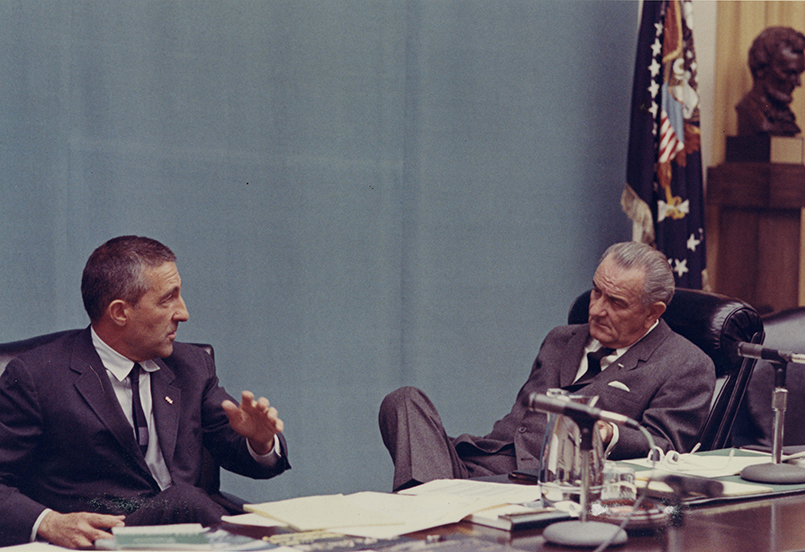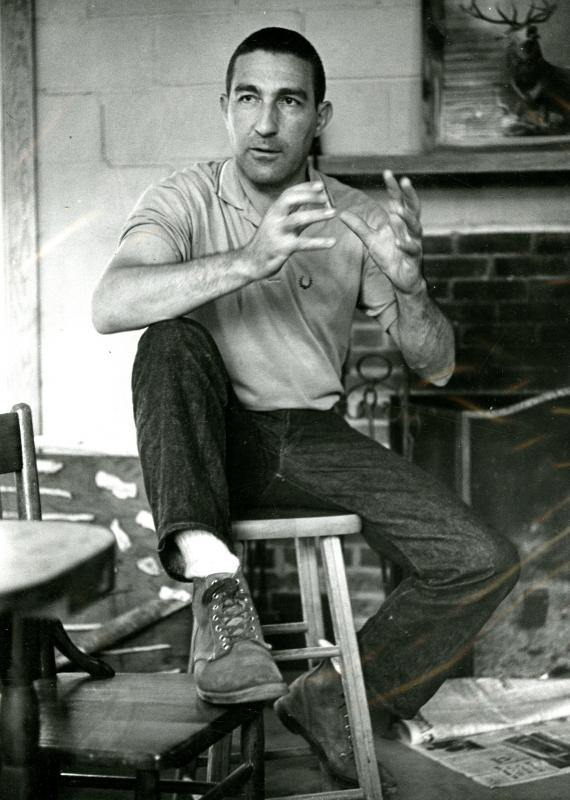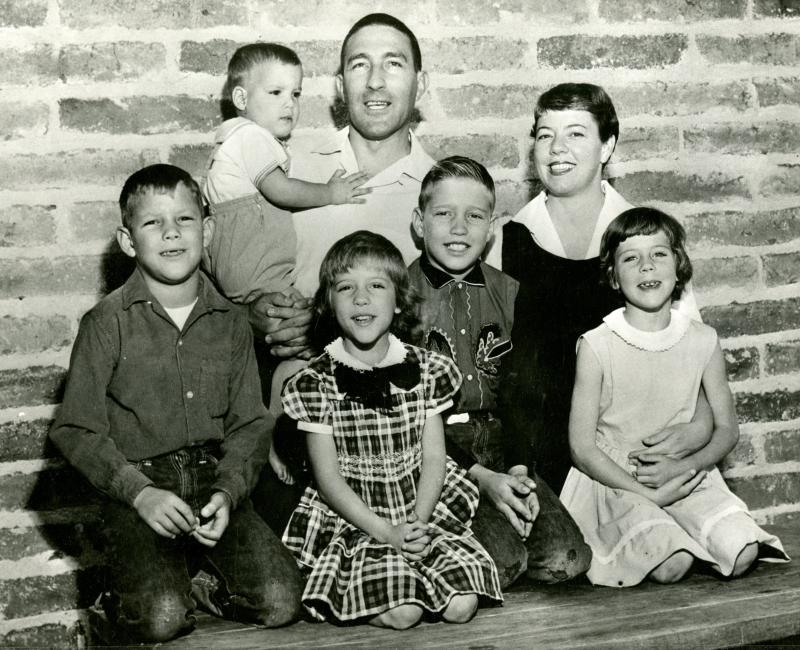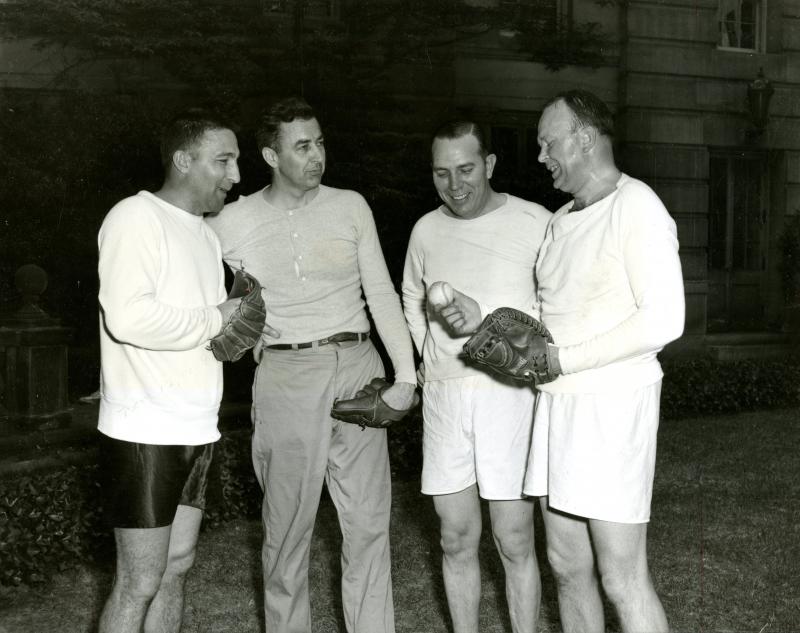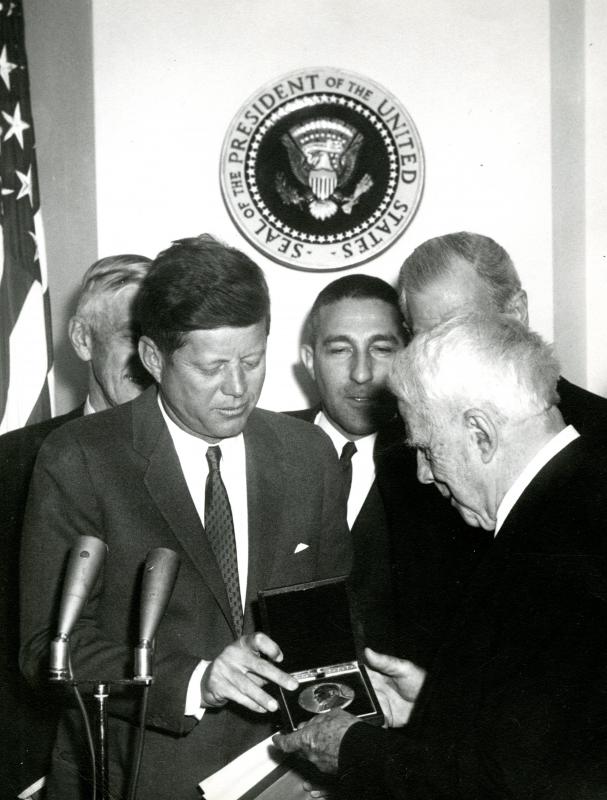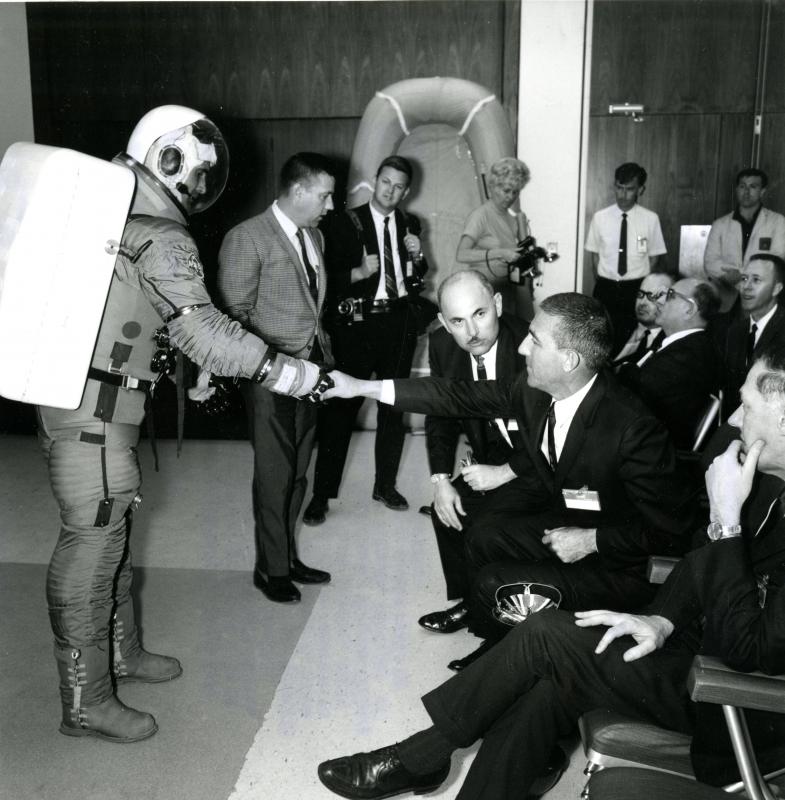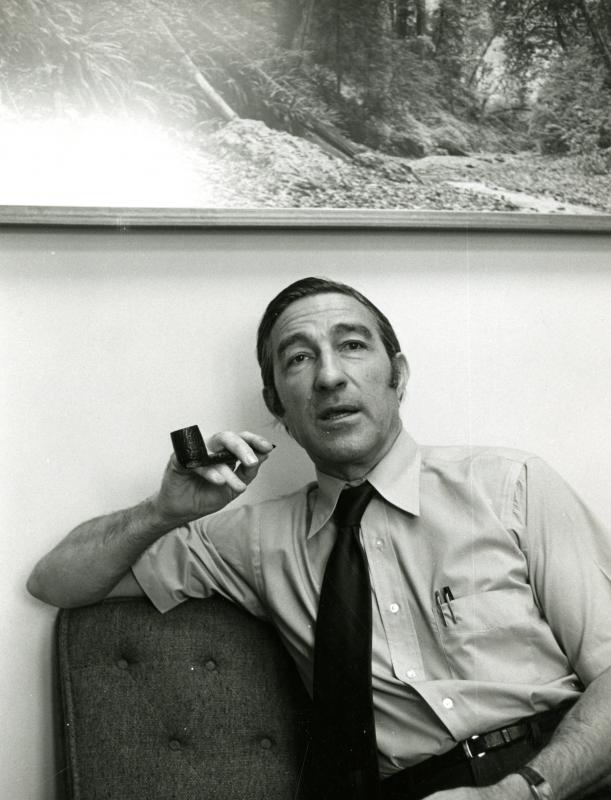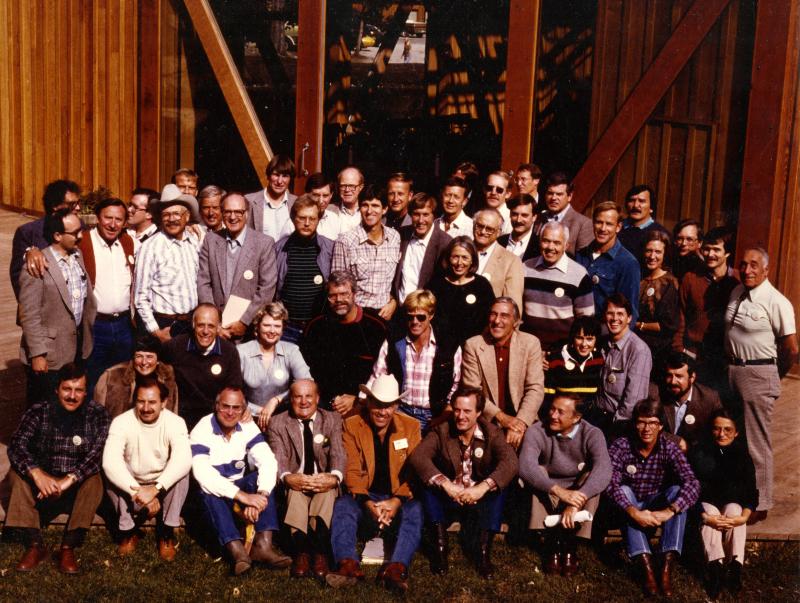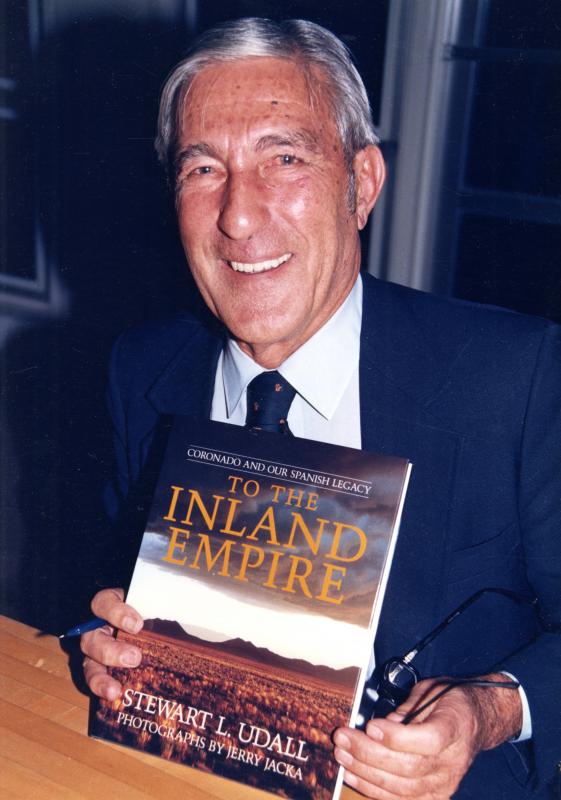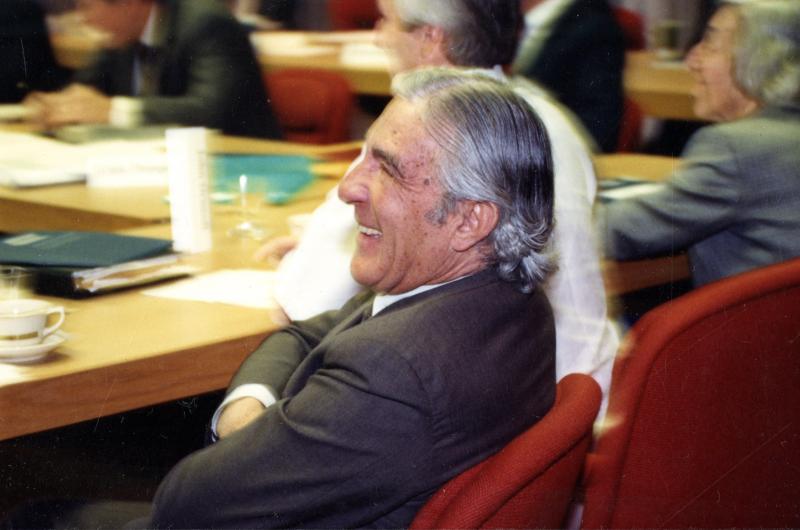Career Chronology
1920
Born January 31, 1920 in Saint Johns, Arizona, to Levi Stewart (1891-1960) and Louise Lee Udall (1883-1974). Siblings: Inez, Elma, Morris, Eloise, and Burr. As a young boy Stewart worked on family farm in St. Johns. Stewart was remembered by his mother as a child with tremendous energy and an unquenchable curiosity.
1926-1937
Attended elementary and high school in St. Johns. While in high school he was active in basketball, football, tennis, and served as freshman class president.
1937-1938
Attended Eastern Arizona Junior College, Thatcher, Arizona.
1938-1940
Attended the University of Arizona, Tucson.
1940-1942
Performed Mormon missionary work in Pennsylvania and New York
1942 -1945
Joined the Air Force during World Water II where he served in Italy as an enlisted B24 gunner with the Fifteenth Air Force. He flew fifty missions over Western Europe and received the Air Medal with three Oak Leaf Clusters.
1946
Returned to the University of Arizona after a five year absence. He played guard on the first Arizona basketball team to represent the state in a national invitational tournament at Madison Square Garden.
1947
Married Erma Lee Webb, they eventually had a family of six children
1948
Received law degree, was admitted to the Arizona bar, and commenced the practice of law in Tucson.
1949-1954
Established law firm of Udall and Udall with his brother Morris K. Udall. Stewart was vice-chairman for the Democratic Party's central committee. He also served as treasurer of the Pima County Legal Aid Society, president of the Amphitheater school board, and trustee of School District 16.
1954
Elected to the House of Representatives as a Democrat in District 2 from Arizona. He won the seat vacated by Harold A. Patten (D). In a heated race with Henry Zipf, Udall received 68,085 votes to Zipf's 41,587.
1955
Appointed to two major committees: Interior and Insular Affairs, and Education and Labor, where he worked closely with John F. Kennedy on labor reform. Stewart was also a member of the Joint Committee on Navajo-Hopi Indian Administration.
Only freshman selected by Speaker Sam Rayburn to represent the six member House delegation at the first NATO parliamentary conference in 1955.
Co-sponored a bill which became Public Law 84-381 to increase the national minimum wage to $1.00 an hour.
1956
Sponsored a bill which became Public Law 84-572 which authorized the Secretary of the Interior to transfer approximately nine acres of land on the Hualapai Indian Reservation, Arizona to school district 8, Mohave County Arizona.
Defeated Jack Speiden 82,110 to 54,596 in Congressional election.
Wrote an article entitled "The Seniority System is Losing its Grip" for the New York Times as part of his campaign to reform congress.
1957
Worked on legislation which created the Glen Canyon Dam and fought to locate the town of Page on the so called "Arizona Side" of the Dam.
Successfully campaigned to adopt new rules for the Education and Labor Committee. Stewart modeled these rules on reforms adopted by the Interior and Insular Affairs Committee in the early 1950s.
1958
Defeated Jack Speiden again 79,651 to 51,140.
Sponsored House bill authorizing the Papago Indian Tribe to lease 2,400 acres of land at Kitt Peak to the National Science Foundation.
1959
Organized orientation sessions for freshman congressmen.
1960
Served as the Arizona campaign chairmen for Kennedy. During the 1960 Democratic Convention Udall swung 17 Arizona votes from Lyndon B. Johnson to John F. Kennedy.
Won his fourth term in Congress he ran against fellow Tucsonan Mac Matheson, Udall received 68,727 votes and Matheson 55,1963.
Appointed Secretary of the Interior by John F. Kennedy.
1961
Arranged for Robert Frost to read from his poetry at President Kennedy's Inauguration.
Established Cape Cod, Massachusetts, as a national seashore.
Traveled to Japan and climbed Mount Fiji in winter.
1962
Traveled to Russia, accompanied by Robert Frost, to inspect their hydro-electric power industry.
Established the Bureau of Outdoor Recreation to coordinate all federal outdoor programs.
Notified George P. Marshall owner, of the Washington Redskins football team, that the Redskins were welcome to play in the newly built stadium in Washington, D.C., provided they become an integrated team. The stadium was built with federal funds and located on land under the jurisdiction of the Department of the Interior.
1963
Published first book The Quiet Crisis which traces the American environmental attitudes and practices, book became a number one best seller.
Traveled to Africa and conquered Mount Kilimanjaro.
1964
President Johnson signed The Wilderness Bill on September 3, creating a national wilderness preservation system of 9.2 million acres of federal land, mostly in the West.
The Land and Water Conservation Fund was established to help local, state, and federal agencies acquire new park lands.
1965
Ellis Island was added to the Liberty Island National Monument.
Assateague Island, located in Maryland and Virginia, was established as a national seashore.
Established Fire Island off the coast of Long Island, New York, as a national seashore.
Established Canyonlands, located in the heart of the Colorado Plateau, Utah, as a national park.
President Johnson signed the Water Quality Act of 1965.
1966
Established Guadalupe Mountains, Texas, as a national park.
Established Cape Lookout, a series of islands extending 55 miles along the Outer Banks, North Carolina, as a national seashore.
Established Indiana Dunes on Lake Michigan, as a national lakeshore.
Established Pictured Rocks on Lake Michigan, as a national lakeshore.
National Historic Preservation Act signed by President Johnson.
1967
Dedication of Hubbell Trading Post National Historic Site, Arizona.
Live theater returns to Fords Theatre, Washington, D.C., after more than a century of silence.
Conceived and organized a tribute to poet and Lincoln biographer Carl Sandburg at the Lincoln Memorial in Washington, D.C.
1968
Established Padre Island, Texas, as a national seashore.
President Johnson signed the Wild and Scenic Rivers Bill and National Trails Bill.
President Lyndon B. Johnson signed the Central Arizona Project.
Established North Cascades, Washington, as a national park.
Established Redwood National Park, California.
Published 1976: Agenda for Tomorrow. Udall posited that cities be considered as environments and suggested that cleaning urban areas become a national project.
1969
Resigned as Secretary of Interior when President Nixon took office
Received honorary degree from Harvard.
1969-1970
Visiting professor of Environmental Humanism at Yale University.
1969-1975
Formed Overview, headquartered in Washington, D.C., a pioneering international consulting firm devoted to creating a better environment; served as Chairman of the Board, 1969-73.
1970-1972
Co-authored a twice weekly nationally syndicated column "Udall on the Environment."
1971
Published America's Natural Treasures: National Nature Monuments and Seashores about America's national parks, national monuments, and national reserves.
1972
Functioned as one of Senator McGovern's advisors during the final phase of his Democratic nomination drive for president.
1974
Co-authored The Energy Balloon a detailed analysis of the nation's wasteful energy habits and steps needed to correct them.
1975-1976
Campaign manager for Morris K. Udall's unsuccessful Democratic presidential nomination campaign.
1976
Joined the Washington, D.C., law firm of Duncan, Weinberg, Miller & Pembroke, as a counsel.
1977
Unveiled his portrait at the Interior Department Building, Washington, D.C.
1978
Became lead lawyer against the federal government on behalf of a group of Navajo Indians who were some of the earliest uranium miners in the country and were not warned of the dangers they faced from exposure to uranium. Stewart was also on a team of lawyers representing individuals (downwinders) who lived in Nevada, Utah and the Arizona Strip during the days of atmospheric atomic bomb testing . Eventually he represented workers from the Nevada Test Site. These suits against the government continued over the next twelve years and were considered first in the United States courts and finally in Congress.
1979
After twenty four years in Washington, D.C., moved to Phoenix, Arizona. Opened law office specializing in the fields of human and natural resources.
Filed first claims against the United States government on behalf of eighty five Navajo miners and their survivors.
1980
Filed second suit seeking more than $50 million in damages from United States Government on behalf of former Nevada Test Site workers who were sent into ground zero shortly after a bomb was exploded.
Supported independent candidate for president Representative John D. Anderson.
Elected to the Central Arizona Water Conservation Board.
1982
Expedition along the Coronado Trail for Heard Museum members.
Reelected to the Central Arizona Water Conservation Board.
Joined the Advisory Board of the Institute for Resource Management, a nonprofit organization run by actor Robert Redford.
Conceived and planned conferences on important energy and conservation issues.
1983
Guest lecturer at the University of Denver College of Law summer session.
Organized the first Institute for Resource Management Symposium on the topic "The Future of the Electric Power Industry: Transition to What?"
1984
Visiting professor at the University of Denver Law School.
Navajo Uranium Miners' case against the government was dismissed.
Arranged a three day conference for the Institute for Resource Management to discuss Indian affairs and resources among conservation, industry, and Indian leaders.
1985
Keynote speaker at the dedication of the Coronado Quivira Museum in Rice County, Kansas.
1986
Decided against running for Congress in Arizona's 4th District, a seat vacated by Eldon Rudd.
Presented the Ansel Adams Award, the Wilderness Society's highest conservation award.
Decision in favor of the downwinders was reversed by the appellate court.
1987
Published To the Inland Empire: Coronado and our Spanish Legacy which retraces the trails of Spanish explorer Francisco Vasquez de Coronado as he searched for the "golden cities" of Cibola in what is now Arizona, New Mexico, Oklahoma and Texas.
1988
Published The Quiet Crisis and the Next Generation. Revised edition with nine new chapters of The Quiet Crisis (1963.)
United States Supreme Court declined to review either the miners' or the downwinders' cases, ruled the government was protected by sovereign immunity. Having been defeated in the courts, Udall took the radiation cases to the United States Congress for redress.
1989
Left Phoenix after a decade of residency and moved to Santa Fe, New Mexico, where he continued to write, lecture, and practice law on a limited bases.
Bestowed knighthood by King Juan Carlos of Spain by the Order of Isabel the Catholic for his book To the Inland Empire.
Planned another successful symposium for the Institute for Resource Management on the subject of "Should Nuclear Power in the United States be revitalized?"
1990
The Radiation Exposure Act was signed into law by President George Bush. The act apologized to the victims of uranium sickness and ordered payment of up to $100,000 for miners, ranchers and others exposed to radiation from mining or above ground testing in the late 1940s through 1960s.
Co-authored Beyond the Mythic West which examines change upon the inhabitants and land of the western United States.
Crusaded to repeal the Mining Law of 1872, and became chair for the non-profit Mineral Policy Center.
1991
Published In Coronado's Footsteps which examines Francisco Vasquez de Coronado exploration and discovery of the Southwest.
1992
Received honorary degree from the University of Massachusetts.
Resigned as Board Chairman of the Archaeological Conservancy, Santa Fe, New Mexico.
1993
Co-authored Arizona, Wild & Free with nephew Randy Udall, and the Arizona Game and Fish Department, a look at Arizona's wilderness areas and habitats.
Awarded United Nations Gold Medal for Lifetime Achievement.
Co-authored text for National Parks of America.
Fought against the development of Atalaya Mountain near Santa Fe, New Mexico.
1994
Published The Myths of August:--A Personal Exploration of Our tragic Cold War Affair with the Atom.
Received the Common Cause Public Service Achievement Award for his lifelong protection of the environment and defense of American citizens who were victims of nuclear weapons testing.
Accepted invitation to serve on Board of Directors of the Wilderness Watch.
1995
Reissued To the Inland Empire under new title Majestic Journey.
Received honorary degree from Northland College, Wisconsin
Court found the government not guilty of negligence in the radiation case brought by Nevada Test Site Workers.
1996
Celebrated the Golden Anniversary of the University of Arizona's 1945-46 Basketball team.
Exchanged experiences with Senator Barry Goldwater at a forum to honor the first fifty-five individuals named as Morris K.
Udall Scholars at the University of Arizona, Tucson.
